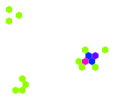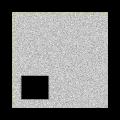Cellular automaton
Cellular automaton (plural: cellular automata) is a discrete model studied in computational theory, mathematics, physics, complex systems, theoretical biology, and microstructure modeling. It consists of a grid of cells, each in one of a finite number of states, such as on or off. The grid can be in any finite number of dimensions. For each cell, a set of cells called its neighborhood is defined relative to the specified cell. An initial state (time t = 0) is selected by assigning a state for each cell. A new generation is created (advancing t by 1), according to some fixed rule (generally, a mathematical function) that determines the new state of each cell in terms of the current state of the cell and the states of the cells in its neighborhood. Typically, the rule for updating the state of cells is the same for each cell and does not change over time, and is applied to the whole grid simultaneously, though exceptions are known, such as the probabilistic cellular automata and asynchronous cellular automata.
History[edit]
The concept of cellular automata was originally discovered in the 1940s by Stanislaw Ulam and John von Neumann while they were working at the Los Alamos National Laboratory. Von Neumann was interested in creating a self-replicating system, which led to the development of cellular automata theory.
Types of Cellular Automata[edit]
There are many types of cellular automata, each defined by its rules, the state of its cells, and its neighborhood. The most common types include:
- Elementary Cellular Automata: These are one-dimensional cellular automata with two possible states for each cell and a neighborhood consisting of the cell itself and its two immediate neighbors.
- Conway's Game of Life: Perhaps the most famous cellular automaton, it is a two-dimensional automaton with cells in two possible states, alive or dead. The state of each cell in the next generation is determined by the current states of the cells in its eight-cell neighborhood according to a specific set of rules.
- Langton's Ant: A two-dimensional universal Turing machine with a very simple set of rules but complex emergent behavior.
- Wolfram's New Kind of Science (NKS): Stephen Wolfram's research into cellular automata and complex systems, proposing that cellular automata have applications in modeling natural phenomena.
Applications[edit]
Cellular automata have been used in various fields for modeling purposes, including:
- Computer Science: For the development of algorithms and data structures.
- Physics: To model physical systems, such as fluid dynamics and thermodynamics.
- Biology: To simulate biological systems, including the growth of plants and the development of cellular structures.
- Epidemiology: To model the spread of diseases.
- Cryptography: In the design of cryptographic systems.
See Also[edit]
References[edit]
<references />
| Conway's Game of Life and related cellular automata | ||||||||||
|---|---|---|---|---|---|---|---|---|---|---|
|
| Complex systems |
|---|
|
Topics
{{{content1}}}
|

This article is a mathematics-related stub. You can help WikiMD by expanding it!

-
Gosper's Glider Gun
-
Torus
-
John von Neumann
-
Oscillator
-
One-dimensional Cellular Automaton Rule 30
-
Cellular Automaton Rule 30
-
Sample Run of Rule 110 Elementary Cellular Automaton
-
Cellular Automaton
-
Gas Velocity
Ad. Transform your life with W8MD's Budget GLP-1 injections from $75


W8MD offers a medical weight loss program to lose weight in Philadelphia. Our physician-supervised medical weight loss provides:
- Weight loss injections in NYC (generic and brand names):
- Zepbound / Mounjaro, Wegovy / Ozempic, Saxenda
- Most insurances accepted or discounted self-pay rates. We will obtain insurance prior authorizations if needed.
- Generic GLP1 weight loss injections from $75 for the starting dose.
- Also offer prescription weight loss medications including Phentermine, Qsymia, Diethylpropion, Contrave etc.
NYC weight loss doctor appointmentsNYC weight loss doctor appointments
Start your NYC weight loss journey today at our NYC medical weight loss and Philadelphia medical weight loss clinics.
- Call 718-946-5500 to lose weight in NYC or for medical weight loss in Philadelphia 215-676-2334.
- Tags:NYC medical weight loss, Philadelphia lose weight Zepbound NYC, Budget GLP1 weight loss injections, Wegovy Philadelphia, Wegovy NYC, Philadelphia medical weight loss, Brookly weight loss and Wegovy NYC
|
WikiMD's Wellness Encyclopedia |
| Let Food Be Thy Medicine Medicine Thy Food - Hippocrates |
Medical Disclaimer: WikiMD is not a substitute for professional medical advice. The information on WikiMD is provided as an information resource only, may be incorrect, outdated or misleading, and is not to be used or relied on for any diagnostic or treatment purposes. Please consult your health care provider before making any healthcare decisions or for guidance about a specific medical condition. WikiMD expressly disclaims responsibility, and shall have no liability, for any damages, loss, injury, or liability whatsoever suffered as a result of your reliance on the information contained in this site. By visiting this site you agree to the foregoing terms and conditions, which may from time to time be changed or supplemented by WikiMD. If you do not agree to the foregoing terms and conditions, you should not enter or use this site. See full disclaimer.
Credits:Most images are courtesy of Wikimedia commons, and templates, categories Wikipedia, licensed under CC BY SA or similar.
Translate this page: - East Asian
中文,
日本,
한국어,
South Asian
हिन्दी,
தமிழ்,
తెలుగు,
Urdu,
ಕನ್ನಡ,
Southeast Asian
Indonesian,
Vietnamese,
Thai,
မြန်မာဘာသာ,
বাংলা
European
español,
Deutsch,
français,
Greek,
português do Brasil,
polski,
română,
русский,
Nederlands,
norsk,
svenska,
suomi,
Italian
Middle Eastern & African
عربى,
Turkish,
Persian,
Hebrew,
Afrikaans,
isiZulu,
Kiswahili,
Other
Bulgarian,
Hungarian,
Czech,
Swedish,
മലയാളം,
मराठी,
ਪੰਜਾਬੀ,
ગુજરાતી,
Portuguese,
Ukrainian









